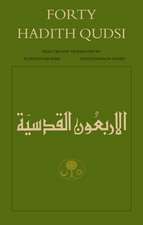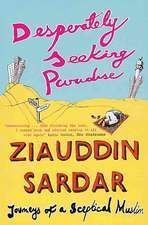Islam: State And Society
Autor Klaus Ferdinanden Limba Engleză Paperback – 11 noi 2004
| Toate formatele și edițiile | Preț | Express |
|---|---|---|
| Paperback (1) | 100.41 lei 6-8 săpt. | |
| Taylor & Francis – 11 noi 2004 | 100.41 lei 6-8 săpt. | |
| Hardback (1) | 1014.74 lei 6-8 săpt. | |
| Taylor & Francis – 15 dec 2017 | 1014.74 lei 6-8 săpt. |
Preț: 100.41 lei
Nou
Puncte Express: 151
Preț estimativ în valută:
19.22€ • 19.95$ • 16.02£
19.22€ • 19.95$ • 16.02£
Carte tipărită la comandă
Livrare economică 22 martie-05 aprilie
Preluare comenzi: 021 569.72.76
Specificații
ISBN-13: 9780700701940
ISBN-10: 070070194X
Pagini: 232
Dimensiuni: 210 x 280 x 12 mm
Greutate: 0.34 kg
Ediția:1
Editura: Taylor & Francis
Colecția Routledge
Locul publicării:Oxford, United Kingdom
ISBN-10: 070070194X
Pagini: 232
Dimensiuni: 210 x 280 x 12 mm
Greutate: 0.34 kg
Ediția:1
Editura: Taylor & Francis
Colecția Routledge
Locul publicării:Oxford, United Kingdom
Cuprins
Introduction , A. K. S. Lambton; Part I ON CONTEMPORARY ISLAMIC STUDIES; Chapter 1 THE PURPOSE OF ISLAMIC STUDIES, Christopher Toll; Chapter 2 THE CONTEMPORARY DEBATE IN THE MUSLIM WORLD ON THE DEFINITION OF “;HUMAN RIGHTS”, Jan Hjärpe; Chapter 3 THE SOCIO-POLITICAL ASPECTS OF THE MODERN ISLAMIC MISSION, Gasym Mamed Ogly Kerimov; Part II AUTHORITY AND THE STATE; Chapter 4 THE CONCEPT OF AUTHORITY IN ISLAMIC THOUGHT, Mohammed Arkoun; Chapter 5 The Origins of the Islamic State, Hichem Djaït; Chapter 6 ADMINISTRATION IN THE ISLAMIC STATE: AN INTERPRETATION OF THE TERMS “;DHIMMA” AND “;JIZYA”, Jøurgen Bæk Simonsen; Chapter 7 State and Politics in the Philosophy of Sh?h Wal?y All?h, Mahmood A. Ghazi; Part III SECULARIZATION: NATION-STATE AND MODERNIZATION; Chapter 8 ISLAM AND CIVIL SOCIETY, Mehd? Mozaffari; Chapter 9 NATION-STATE BUILDING IN SYRIA: BA'TH AND ISLAM — CONFLICT OR ACCOMMODATION?, Annika Rabo; Chapter 10 ISLAM: WHAT IS ITS POLITICAL SIGNIFICANCE? THE CASES OF EGYPT AND SAUDI ARABIA, Gorm Rye Olsen; Chapter 11 WHEN MUSLIM IDENTITY HAS DIFFERENT MEANINGS: RELIGION AND POLITICS IN CONTEMPORARY AFGHANISTAN, Asger Christensen; Chapter 12 AFGHANISTAN: THE DEVELOPMENT OF THE MODERN STATE, Asta Olesen; Chapter 13 LABOUR ORGANIZATION IN LIBYA, Maja Naur; Chapter 14 CULTURE AND MINORITIES IN THE ARABO-ISLAMIC IDENTITY OF ALGERIA, Tuomo Melasuo; NOTES;
Descriere
Descriere de la o altă ediție sau format:
You know mathematics. You know how to write mathematics. But do you know how to produce clean, clear, well-formatted manuscripts for publication? Do you speak the language of publishers, typesetters, graphics designers, and copy editors?
Your page design-the style and format of theorems and equations, running heads and section headings, page breaks, fonts, and spacing-makes the difference between, awkward, hard-to-read publications and coherent, professional ones. The Handbook of Typography for the Mathematical Sciences is your key to exercising control over how your books and articles look, read, and ultimately communicate your ideas.
Focusing on TeX, today's medium of choice for producing mathematical documents, the author illuminates all of the issues associated with page design and seeing your manuscript smoothly and accurately through each step of its publication.
Learn how to format, edit, and layout a page
Examine a variety of graphics options: Postscript bitmaps, *.jpg, *.gif, and *.pdf files
Discover powerful tools available for indexing, bibliographies, tables, and diagrams
Access a compendium of all TeX commands commonly used in mathematical writing
Explore ways to include diskettes, source code, or software available on the Internet with you publications
Becoming acquainted with this material will make you a well-informed author equipped to deal with publishers, compositors, editors, and typesetters, with TeX consultants, copy editors, and graphics designers-an author who has a better understanding of the publishing process and is able to create better mathematics books.
You know mathematics. You know how to write mathematics. But do you know how to produce clean, clear, well-formatted manuscripts for publication? Do you speak the language of publishers, typesetters, graphics designers, and copy editors?
Your page design-the style and format of theorems and equations, running heads and section headings, page breaks, fonts, and spacing-makes the difference between, awkward, hard-to-read publications and coherent, professional ones. The Handbook of Typography for the Mathematical Sciences is your key to exercising control over how your books and articles look, read, and ultimately communicate your ideas.
Focusing on TeX, today's medium of choice for producing mathematical documents, the author illuminates all of the issues associated with page design and seeing your manuscript smoothly and accurately through each step of its publication.
Becoming acquainted with this material will make you a well-informed author equipped to deal with publishers, compositors, editors, and typesetters, with TeX consultants, copy editors, and graphics designers-an author who has a better understanding of the publishing process and is able to create better mathematics books.


















